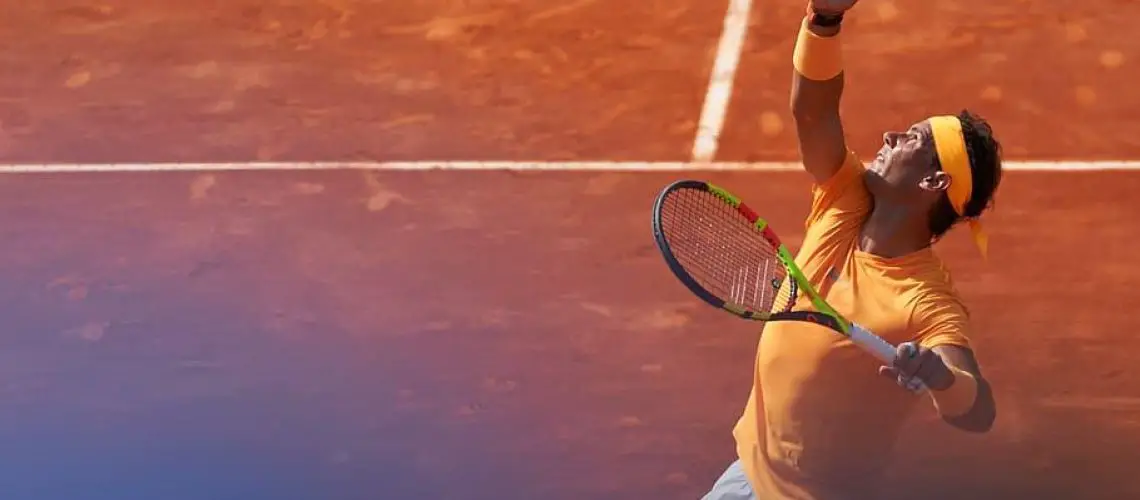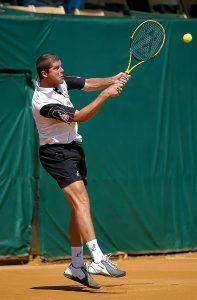We may earn money or products from the companies mentioned in this post.
Introduction

Welcome to the world of racquet sports! In this article, we’ll dive into the exciting worlds of pickleball and tennis Both sports have gained immense popularity in recent years, captivating players of all ages and skill levels
Brief Overview of Pickleball and Tennis
Pickleball and tennis may appear similar at first glance, but they each possess their own unique characteristics that set them apart
1 Origins of Both Sports
Tennis, often referred to as the “sport of kings,” traces its roots back to 12th century France It was initially played with bare hands before evolving into the use of gloves and then wooden racquets Today, it is a globally recognized sport with prestigious tournaments like Wimbledon and the US Open
In contrast, pickleball emerged much later in 1965 when three dads from Washington invented a new game for their families They combined elements from tennis, badminton, and ping pong to create a game that would be enjoyable for all ages The name “pickleball” even came about as a tribute to one of their dogs named Pickles!
2 Popularity and Growth Worldwide
Tennis has long been hailed as one of the most popular sports worldwide, attracting millions of players and fans alike Its grand slam events draw massive crowds every year, showcasing incredible athleticism and skill on both grass and hard courts
Pickleball’s popularity has skyrocketed in recent years, particularly among older adults looking for a fun way to stay active The sport’s accessibility (thanks to smaller courts) has made it incredibly appealing for beginners who want to dip their toes into racket sports without feeling overwhelmed
Purpose of the Article
The purpose of this article is to shed light on the key differences between pickleball and tennis Whether you’re a seasoned player or someone curious about picking up a new sport, understanding these distinctions will help you make an informed decision about which game suits your interests and preferences
Additionally, we’ll address common questions that both newcomers and enthusiasts often have about these two sports So, let’s dive in and explore the world of pickleball and tennis!
Equipment and Court Differences

When it comes to the game of tennis and pickleball, there are several key differences in the equipment and court layout Let’s take a closer look at these variations
Court Size and Layout
In tennis, the court dimensions and markings are quite distinct The court is divided into several sections, including singles and doubles lines These lines determine the boundaries for each type of play Additionally, there are baselines, service boxes, sidelines, and a center mark that all contribute to the strategic nature of the game
On the other hand, pickleball courts have their own unique dimensions and markings One notable feature is the non-volley zone, also known as the “kitchen” This area near the net prohibits players from hitting volleys while standing inside it Furthermore, pickleball courts have right and left serving areas along with baselines and sidelines that demarcate the playing area
Racquets/Paddles Differences
The racquets used in tennis differ significantly from the paddles used in pickleball Tennis racquets are typically constructed using various materials such as graphite or aluminum alloy frames combined with synthetic strings These racquets come in different weights and grip sizes to cater to individual player preferences
Pickleball paddles, on the other hand, are designed without strings They are composed of materials such as wood or composite materials like graphite or fiberglass Paddle dimensions vary but generally adhere to specific guidelines set by governing bodies to ensure fair play
Ball Comparison
The difference between tennis balls and pickleballs extends beyond just their size and weight; it also lies in their construction
Tennis balls consist of pressurized rubber cores covered with felt material, which gives them a distinctive bounce and grip on the court This combination allows for powerful shots and precise control during gameplay
Pickleballs, however, are made of lightweight perforated plastic The holes in the ball reduce its air resistance, giving it a slower pace and unique flight pattern This makes pickleball more accessible to players of varying ages and skill levels
Rules and Gameplay Differences

When it comes to tennis and pickleball, there are some notable differences in the rules and gameplay Let’s dive into the key distinctions between these two sports
Playing Formats: Singles & Doubles in Both Sports
In both tennis and pickleball, players can choose to participate in singles or doubles matches This provides flexibility for players who prefer individual competition or enjoy teaming up with a partner Whether you prefer the intensity of one-on-one battles or the dynamic strategies of doubles play, both sports offer options to suit your preferences
Scoring Systems
The scoring systems in tennis and pickleball differ significantly In tennis, points are awarded using a unique system that goes from love (0) to 15, 30, 40, and then deuce when the score is tied at 40-40 To win a game, a player must win by two points after reaching deuce
Pickleball employs a rally scoring system where each serve results in a point being awarded if won This means every serve counts towards the overall score regardless of which player serves
Serving Rules Variations
Tennis and pickleball also have variations in their serving rules In tennis, players execute an overhead serve into the opposite service box across the net This requires power and accuracy to place the ball strategically away from their opponent’s reach
In contrast, pickleball utilizes an underhand serve technique where players must hit the ball below waist level into the correct quadrant on their opponent’s side of the court This style of serving allows for more control and precision when starting each point
Double Bounce Rule in Pickleball
An interesting rule unique to pickleball is the double bounce rule This means that when the ball is served, it must bounce once on each side before players can volley it After these initial bounces, the ball can be played in the air or off a bounce This rule adds an extra layer of strategy and requires players to think tactically about shot placement and timing
Non-Volley Zone Rule in Pickleball
Pickleball also has a non-volley zone, commonly referred to as “the kitchen” This area extends seven feet from the net on both sides of the court and restricts players from hitting volleys (hitting the ball in mid-air) while inside it This rule prevents players from dominating at close range and encourages strategic play near the net
These rules and gameplay differences between tennis and pickleball create unique challenges and strategies for players in each sport Whether you prefer the finesse of tennis or the fast-paced action of pickleball, both sports offer exciting opportunities for competition and enjoyment
Strategies & Techniques Differences

In the world of racket sports, tennis and pickleball stand out as popular choices for players seeking a thrilling and challenging experience While both sports share similarities in terms of gameplay, there are distinct strategies and techniques that set them apart Let’s delve into these differences to gain a deeper understanding
Variations in playing styles
When it comes to playing styles, tennis and pickleball showcase contrasting approaches on the court In tennis, aggressive baseline play reigns supreme Players unleash powerful groundstrokes from the back of the court, aiming to dominate their opponents with raw strength and accuracy
On the other hand, pickleball introduces a unique strategy known as dinking This technique involves hitting soft shots close to the net, forcing opponents to move forward and increasing the likelihood of an unforced error The delicate touch required for successful dinking sets pickleball apart from its tennis counterpart
Importance of net play in both sports
Net play is crucial in both tennis and pickleball but manifests differently in each sport In tennis, volleys and overhead smashes take center stage at the net Players must possess quick reflexes and precise timing to execute these shots effectively and dictate the flow of the game
Pickleball, however, presents a unique challenge with its non-volley zone or “kitchen” This area near the net restricts players from hitting volleys unless they are positioned behind it To navigate this limitation, pickleball players employ a soft game technique where they hit softer shots instead of hard volleys when near the kitchen boundary
Differences in groundstrokes & spin techniques
The groundstrokes and spin techniques employed in tennis and pickleball also differ significantly In tennis, players have a wide array of options at their disposal They can generate topspin to add bounce and control to their shots, utilize slice for deceptive spins, or go for flat strokes for maximum power
On the other hand, pickleball’s paddle structure limits the spin options available to players While some degree of topspin and backspin is possible, it is not as pronounced as in tennis The emphasis in pickleball lies more on shot placement and strategic positioning rather than spin manipulation
Footwork and movement differences between the sports
Another aspect where tennis and pickleball diverge is in footwork and movement on the court Tennis demands a greater level of agility and speed due to its larger court size Players must cover vast distances quickly, constantly adjusting their position to reach balls efficiently
In contrast, pickleball’s smaller court dimensions require less ground to be covered However, precise footwork remains essential for maintaining balance and positioning during rallies The shorter distances involved allow players to focus more on quick lateral movements rather than sprinting across large areas like in tennis
In conclusion, while both tennis and pickleball share similarities as racket sports, they possess distinct strategies and techniques that make them unique from one another Understanding these differences can help players enhance their skills in their chosen sport or even explore new avenues of play across multiple disciplines
Conclusion

After exploring the key differences between pickleball and tennis, it is clear that these sports offer unique experiences for players of all skill levels While both sports share similarities in terms of rules and equipment, they also have distinct characteristics that set them apart
Summary of key differences between pickleball and tennis
In summary, pickleball is a fast-paced game played on a smaller court with a paddle and a plastic ball The sport emphasizes agility, quick reflexes, and precision shots On the other hand, tennis is played on a larger court with a racket and a felt ball It requires more endurance, power, and strategic gameplay
The scoring systems in pickleball and tennis also differ significantly In pickleball, points are scored only by the serving team whereas in tennis both players have an opportunity to score points during each rally This difference adds an extra layer of excitement and intensity to both sports
Furthermore, pickleball is known for its emphasis on socializing and creating a welcoming atmosphere on the courts The smaller court size allows for closer interactions between players while fostering camaraderie among participants Tennis, being played on larger courts with greater distances between players, may not offer the same level of socializing opportunities
Encouragement to try both sports for fun, fitness, and socializing
If you’re looking for an enjoyable way to stay active while meeting new people or spending time with friends and family, why not give both pickleball and tennis a try? Each sport offers its own unique benefits that can enhance your overall well-being
Pickleball provides a fantastic opportunity to improve your hand-eye coordination while engaging in friendly competition Its smaller court size makes it easier to learn for beginners while still offering plenty of challenges for advanced players Plus, the social aspect of pickleball creates a supportive and inclusive environment that is perfect for forging new friendships
Tennis, on the other hand, offers a more dynamic and physically demanding experience It improves cardiovascular fitness, strength, and agility The larger court size allows for longer rallies and strategic gameplay that can be both mentally stimulating and physically rewarding Tennis also provides opportunities to join leagues or participate in tournaments, adding an extra level of excitement to the sport
Ultimately, whether you choose pickleball or tennis (or even both!), you’re bound to have a great time while reaping the numerous health benefits these sports offer So grab your paddle or racket, head out to the courts, and immerse yourself in the joy of playing these fantastic games
Useful Links

Pickleball Vs Tennis | Which One Rules?
Tennis vs Pickleball: What’s Your Preference?
Pickleball vs Tennis: What’s The Difference?
Pickleball vs. Tennis – A Comparison and Frequently …
It’s Tennis vs. Pickleball vs. Padel. Or Is It?
5 Differences Between Pickleball and Tennis
Pickleball Vs Tennis – 9 Key Differences
Pickleball is America’s fastest-growing sport. These people …
Why Tennis is Better Than Pickleball – YouTube
7 Key Differences Between Pickleball vs Tennis –
4 Key Differences Between Tennis and Pickleball
Are Pickleball rules the same as Tennis? – Racketopia
Exploring the Key Differences Between Tennis and Pickleball
Why pickleball might be easier (and more fun) than tennis
5 Key Differences Between Pickleball and Tennis – Play-PKL
Pros and cons: Comparing the health benefits of tennis and …
Is Pickleball Easier To Learn Than Tennis? | Paddle2Racket
5 Major Differences Between Pickleball and Paddle Tennis
What is the Difference Between Pickleball and Tennis?






